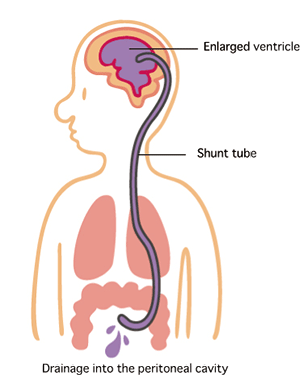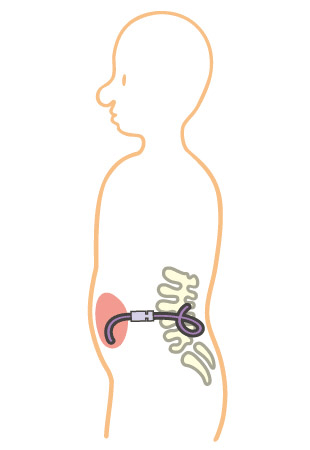- HOME
- For Patients
- Normal pressure hydrocephalus
- Treatment of normal pressure hydrocephalus
Normal pressure hydrocephalus
- About normal pressure hydrocephalus
- Symptom of normal pressure hydrocephalus
- Diagnosis of normal pressure hydrocephalus
- Treatment of normal pressure hydrocephalus
Treatment of normal pressure hydrocephalus
If the tap test shows a suitable response to the removal of cerebrospinal fluid, surgery may be carried out to perform full-scale drainage of the fluid accumulated in the cerebral ventricles. Under general anesthetic, a small hole around the size of the index finger is opened in the skull, and a silicone tube around 2 mm in diameter is inserted through this into a cerebral ventricle. This tube runs under the skin of the head and neck and across the abdomen, still under the skin, until it finally reaches the area under the intestines. A total of four small incisions are made to enable passage of the tube. The excess cerebrospinal fluid that accumulates in the brain is carried via this tube to the abdomen, for reabsorption by the body. During the operation, a valve is implanted to regulate the flow of cerebrospinal fluid. This valve is magnetic, and after the surgery has finished, a magnet is used to control the pressure in the valve from outside the skin, according to information from CT and how quickly symptoms improve. This surgery for NPH is called a "shunt". Shunts can also be used to drain cerebrospinal fluid from the lower back to inside the abdomen.
The shunt procedure for NPH is effective in improving walking for around 90% of patients and in improving forgetfulness and incontinence for around 50%. Some patients experience dramatic improvements in their daily lives.
NPH is diagnosed by an internist specializing in neurology or by a neurosurgeon. Treatment becomes less effective as the condition progresses and forgetfulness and incontinence occur in addition to difficulties with walking, so early consultation is recommended.
[ Shunt procedure: V-P shunt ]

[ Shunt procedure: L-P shunt ]








